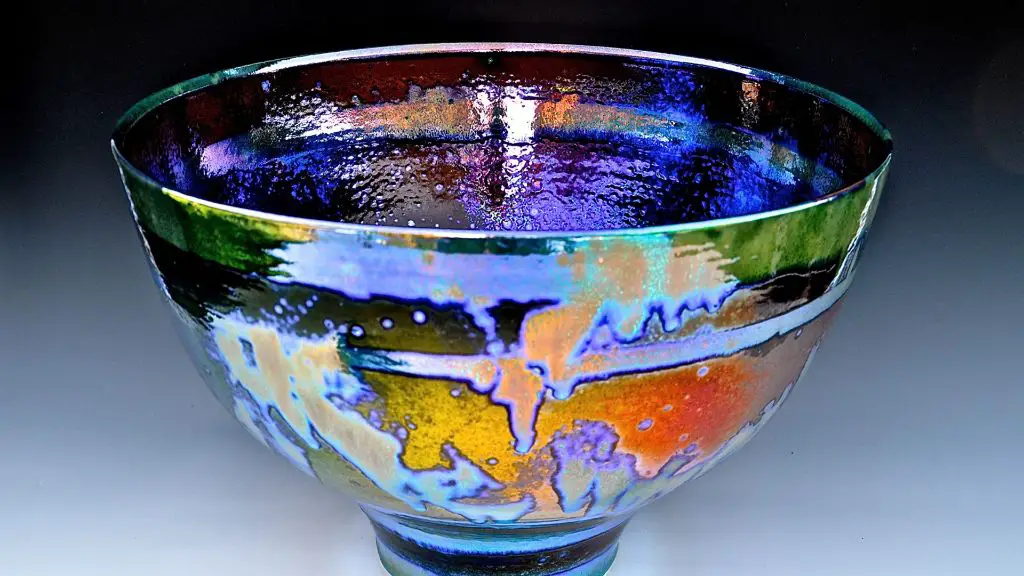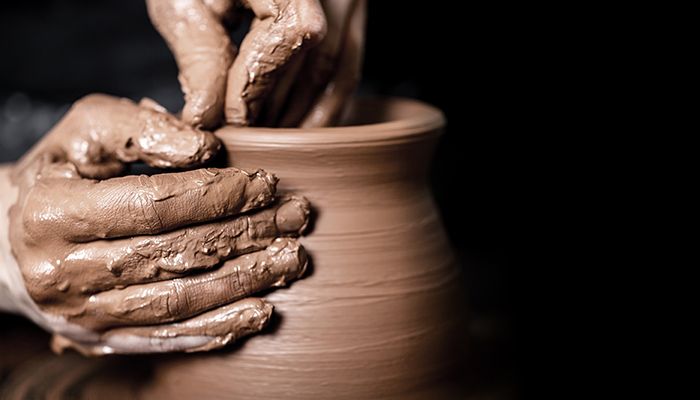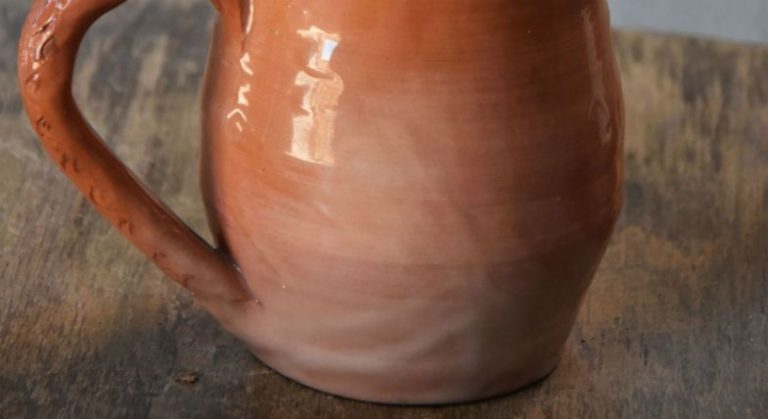Clay Pottery Raku Firing Techniques: A Unique Approach
Raku pottery has a long and storied history originating in Japan during the late 16th century. The term “raku” translates to “enjoyment” or “comfort” and refers to a unique quick-firing pottery technique (https://www.gathered.how/arts-crafts/raku-pottery). Raku ware was originally created for use in the Japanese tea ceremony, prized for its rustic and natural aesthetic.
Raku pottery is made using specialized raku clay and fired at lower temperatures between 1475 – 1800°F. The pottery is removed from the kiln while still glowing hot and placed into containers with combustible materials like sawdust or leaves. This reduction firing process produces distinctive crackled and blackened pottery surfaces (https://artincontext.org/what-is-raku-pottery/).
The raku firing process yields unpredictable and serendipitous results, making each raku piece truly unique. Raku pottery embraces imperfections like fire scorching and texture that add to its rustic, natural charm. The raku tradition represents a Japanese aesthetic of honoring chance and recognizing beauty in imperfection.
Raku Clay Bodies
The type of clay used is crucial for achieving the unique crackled effects of raku pottery. Raku clays are specially formulated to withstand the quick heating and cooling of the raku firing process without cracking or exploding1. The clay body must have the right balance of porosity, strength, and thermal shock resistance.
There are two main types of clay used for raku: stoneware clay and earthenware clay. Stoneware clays like porcelain and clay with grog or chamotte added have higher firing temperatures, allowing the ware to vitrify and become less porous. This provides strength but reduces crackle effects. Earthenware clays are more porous and prone to cracking, producing more dramatic raku crackle results2.
Finding the right balance of clay porosity is key for raku pottery. More porous bodies absorb more glaze during firing for flowing glaze effects. But too much porosity can lead to weak forms that crack excessively or even explode from thermal shock. Raku clay recipes aim for optimal porosity suited for raku’s unique rapid firing.
Creating Raku Pottery Forms
When creating forms for raku pottery, both handbuilding and wheelthrowing techniques can be used successfully. However, there are some important considerations to keep in mind when designing vessels intended for raku firing.
Handbuilding techniques like pinch pots, slabs, and coils are all great options for making raku forms. These methods allow total control over the shape and size of pieces. Raku clay is often quite coarse and groggy, which makes it ideal for handbuilding. The clay holds its form well but is also forgiving during construction. For best results, keep walls relatively thick and avoid delicate detailing that may slump or crack during firing. Sturdy, simple forms tend to fare best.
Wheelthrowing raku vessels requires a smooth, plastic clay body and some experience working quickly on the wheel. Pieces must be thrown with thicker walls – approximately 1/4″ to 1/2″ thick. The added thickness prevents warping or cracking during the dramatic temperature shifts of raku firing. forms with gentle contours tend to survive firing better than those with sharp angles or undercuts. Consider altering shapes after throwing while the clay is still wet and flexible. https://potterycrafters.com/how-to-make-raku-pottery/
For both methods, scale is an important consideration for raku. Very large, thick-walled pieces will likely experience cracking or even explosions from trapped air or moisture during raku firing. Small to medium sized vessels with a maximum width of 6-10 inches tend to fare best. If choosing to make a large statement piece, increase wall thicknesses and test carefully.
Applying Raku Glazes
Raku glazes have unique properties that enable the distinctive crackled effects seen on finished raku ware. These glazes are specially formulated to withstand the thermal shock of the raku firing process. According to raku expert Linda Arbuckle, most raku glazes consist of 50-80% silica, 10-30% alumina, 2-8% calcium oxide, and 1-5% colorants or opacifiers (https://www.lindaarbuckle.com/handouts/raku-glaze-recipes.htm).
Typical raku glaze ingredients include silica, zircon, kaolin, whiting, dolomite, and small amounts of colorants like red iron oxide, cobalt carbonate, or copper carbonate. Some common base glazes are Raku Base (silica, whiting, zircon) or NewBatz (silica, whiting, kaolin, dolomite). Popular recipes build on these bases by adding 5-15% colored glaze stains.
When applying raku glazes, it is important to use enough to fully coat the bisqueware surface while avoiding excess drippy glaze. Glazes can be applied via dipping, pouring, or brushing. Dipping gives an even coating if done properly by dipping vertical forms top down. Brushing also allows precise glaze placement for creating patterns or leaving areas unglazed.
Pre-firing Prep
Proper preparation before firing is a critical step for achieving the unique effects of raku pottery. After forming and drying raku pieces, they must be bisque fired before applying glazes and raku firing. Bisquing raku clay requires firing to a lower temperature, typically around 1700°F-1800°F, to harden the clay body and prepare it for glazing.
Resists or masking techniques may be used on raku ware prior to bisque firing to create contrasts between glazed and unglazed areas. These protected areas will show the natural terracotta color of the clay after raku firing. Masking fluid, latex resist, or wax can be applied to create patterns.
When doing the raku firing itself, it’s essential to have proper ventilation to allow smoke and gases to escape safely. An opening in the kiln or firing chamber is needed along with good airflow. Having adequate venting prevents smoke buildup during the dramatic cooling and reduction process that creates the signature raku surface effects.
Sources:
https://www.soulceramics.com/pages/raku-firing
https://www.instructables.com/Raku-Pottery/
The Raku Firing Process

The raku firing process involves carefully controlling the kiln temperature and removing pots at critical moments to achieve the distinctive raku effects. There are several key phases to the raku firing process:
Heating phase – The kiln is heated rapidly, sometimes as quickly as 300°F per hour, up to around 1600-1800°F. The goal is to heat the clay and glazes very quickly to induce cracking and crazing effects.[1]
Reduction phase – Once the desired temperature is reached, the ware is removed from the kiln using long metal tongs and placed into a container with combustible materials like sawdust or leaves. This material ignites, which reduces oxygen and creates a smoking effect. The pieces are left to smoke for 5-20 minutes. This reduction process is what creates the distinctive crackled glaze effects.[2]
Cooling phase – After smoking, the pieces are either placed in a metal can with combustible materials and sealed, or quenched in water. This rapid cooling helps preserve the crackled surface.
Finishing – Once cool, any excess carbon is brushed off. The rapid firing and reduction process leaves the clay quite porous, so a sealant is usually applied. The pieces are then ready to be completed and displayed.
Carefully controlling the firing schedule, removing pots at the right moments, and properly finishing through smoking and sealing are key to achieving beautiful one-of-a-kind raku pottery.
[1] https://www.taea.org/taea/Docs/2013/TAEA-STAR-2013-Fall.pdf
[2] https://www.taea.org/taea/Docs/2014/TAEA-Star-2014-Fall.pdf
Achieving Unique Raku Effects
One of the most exciting parts of raku firing is the range of unique visual effects that can be achieved. These effects are the result of the complex chemical interactions between the clay, glaze, and atmosphere during firing. Some of the main raku effects to aim for include:
Crackle Effects: Fine crackle patterns form when the clay and glaze cool and contract at different rates. Using a high thermal shock clay body and thick opaque glaze promotes crackling. Slow cooling also exaggerates the crackle effect.
Luster Effects: Metallic lusters form when vaporized metals re-oxidize on the surface. Copper, silver, and gold lusters produce beautiful iridescent finishes. Sprinkling metal powders over the pot during smoking is key for vibrant lusters.
Carbon Trapping: Introducing combustibles like leaves, wood, and paper during smoking traps carbon on the surface, creating black spotting and patterns. Limiting oxygen exposure during smoking encourages more dramatic carbon trapping effects.
The key to controlling these special effects is carefully managing variables during each stage of firing. The kiln temperature, glaze ingredients, timing of smoking, materials used for smoking, and cooling rate can all be adjusted to achieve the perfect balance of raku magic.
Troubleshooting Issues
Raku firing can be unpredictable, and problems like cracking or glaze faults may occur. Here are some common issues and solutions:
If cracks appear, it could be due to thermal shock from cooling the ware too quickly after removal from the kiln. Allow pieces to cool more slowly by placing them on a bed of combustible materials like sawdust or newspaper. Cracks can also happen if the clay body contains too much grog or is not plastic enough.1
Glaze faults like crawling, pitting, or inadequate melting are often caused by incompatible clay and glaze combinations. Test glazes thoroughly on raku bodies before a full firing. Ensure glazes mature at the correct cone for the clay body. Under-fired glazes may crawl or remain rough.
Bloating or blistering happens when gases get trapped under the glaze during rapid cooling. Allow pieces to cool more slowly or use a more porous clay body to allow gases to escape. Also avoid over-firing glazes.
If glaze falls off during firing, the fit between clay and glaze may be poor. Adjust glaze thickness and test compatibility. Or use raku glazes specially formulated for thermal shock.
Keep good notes during test firings. Compare results across firings and clay/glaze combinations to identify and fix recurring issues.
Finishing and Sealing
Sealing finished raku ware is an important final step to ensure functionality and protect the porous clay body. Raku firing produces a porous, absorbent clay surface that will soak up liquids if left unsealed. Proper sealing allows the ware to hold liquids without leaking or absorbing stains (https://thepotterywheel.com/seal-raku-pottery/).
There are several options for sealing raku pottery:
- Liquid quartz or silica gel – Provides a glasslike coating and excellent water resistance when poured directly into the vessel (https://potterycrafters.com/is-raku-pottery-waterproof/).
- Resin sprays – Spray-on options like polyurethane or acrylic resin offer good moisture protection.
- Food-safe finishes – Beeswax, walnut oil, and some plant-based waxes can provide a natural, food-safe seal.
- Clear glazing – Applying a final clear glaze firing provides a non-porous glass surface.
The sealing method should be selected based on the functional use and desired aesthetics of the finished piece.
Conclusion
Raku pottery provides a unique way for potters to achieve one-of-a-kind effects with unpredictable results. The benefits of raku pottery include the ability to create innovative designs not possible with other techniques. However, raku firing also presents challenges due to its quick, unstable process. As raku continues evolving, innovations like new clay bodies, glazes, and firing methods will arise. Raku endures as a popular ceramics technique because it combines artistic expression, cultural heritage, and the excitement of discovery.
The spontaneous effects achievable through raku firing make it an adventurous art form compared to more controlled ceramic techniques. Raku allows potters to embrace unpredictability and chance designs. While the volatile raku process can bring difficulties, dedicated artists are drawn to the imaginative possibilities. Raku’s rich history and tradition across various cultures also contribute to its lasting popularity.
As raku pottery advances into the future, developments in areas like specialized clays, glazes, and kilns will unlock new potential. Experimenting with the raku process to achieve innovative results drives progress. Despite its challenges, raku promises to remain a vital, evolving art form due to the appeal of its hands-on methods and one-of-a-kind finished pieces.
In the end, raku endures as a beloved pottery technique because it fuses art, history, experimentation, and surprise. The raku firing ritual creates an atmosphere of excitement and wonder unmatched by other methods. For potters seeking exhilarating, idiosyncratic designs, raku pottery delivers a direct connection between artist and fire.


